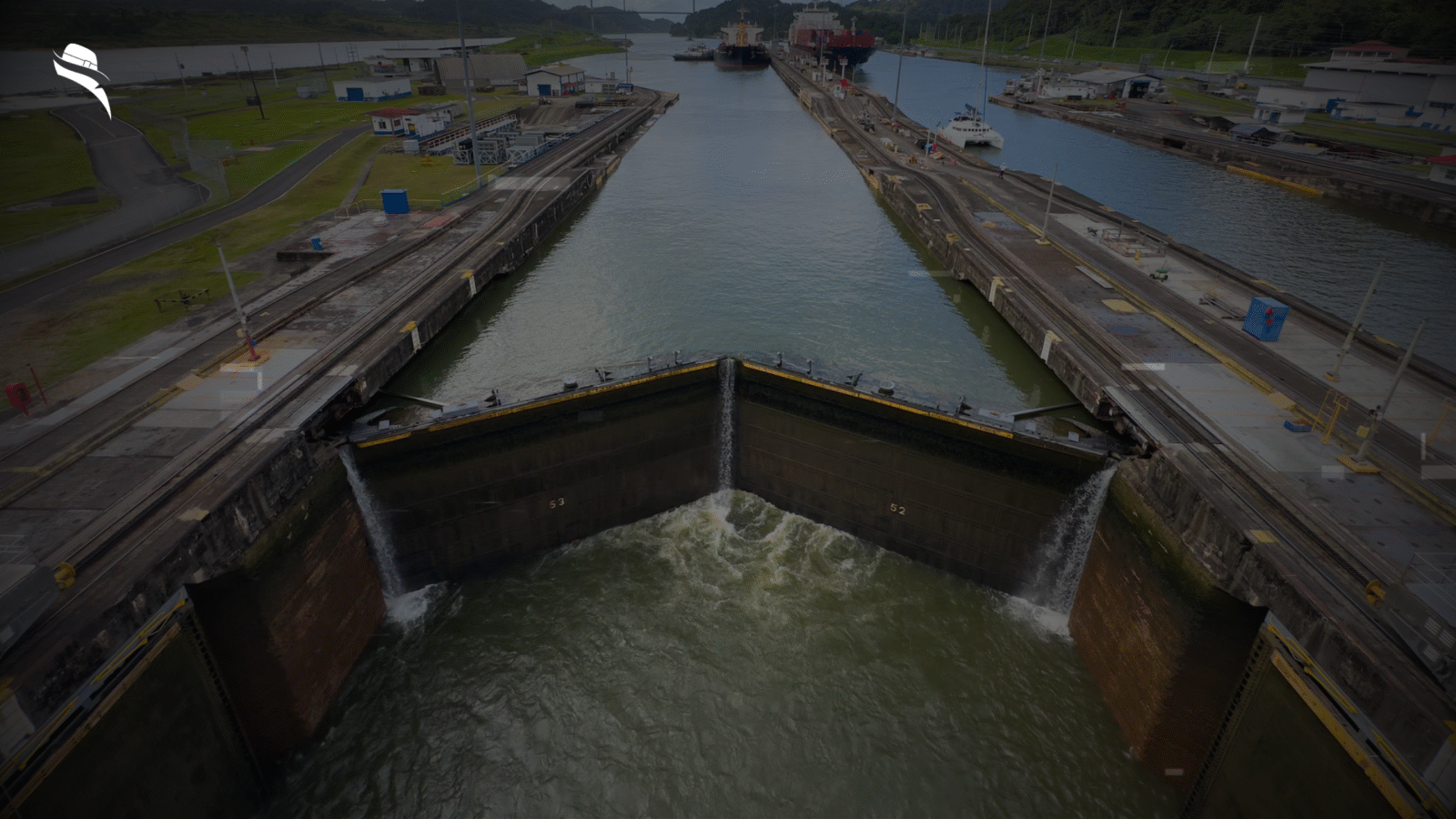The importance of the Panama Canal cannot be overstated, as this 82-kilometre (51-mile) artificial waterway handles over 5% of world trade annually. Connecting the Caribbean Sea with the Pacific Ocean, this engineering marvel has transformed global shipping since its completion in 1914. What began with approximately 1,000 ships per year has grown significantly to 14,702 vessels in 2008, totalling 333.7 million PC/UMS tons.
Located in Central America, the Panama Canal serves as one of the two most strategic artificial waterways in the world, alongside the Suez Canal. Its construction was one of history’s largest engineering projects, costing the United States nearly $500 million (equivalent to about $15.7 billion today). Since its expansion in 2016, the canal has nearly tripled its previous capacity, allowing larger Neopanamax ships to transit. However, this vital trade artery now faces serious challenges. With each ship transit requiring an average of 200 million litres of fresh water, recent droughts have created bottlenecks at what has long been considered one of the world’s busiest trade routes. Additionally, a proposed $22.8 billion sale of nearby ports has raised concerns about the canal’s neutrality and future operations.
The Panama Canal: A Global Trade Lifeline
The Panama Canal stands as one of the world’s most crucial maritime passages, connecting oceans and reshaping global trade routes. This engineering marvel serves as a cornerstone of international commerce, facilitating approximately 6% of global maritime trade annually.
Where is the Panama Canal located?
Situated in the narrow Isthmus of Panama in Central America, the canal creates a vital waterway connecting the Atlantic Ocean (specifically the Caribbean Sea) to the Pacific Ocean. This strategic placement allows the canal to serve as a gateway between the eastern and western hemispheres. The canal cuts across Panama at one of its narrowest points, essentially bisecting the country while creating an artificial pathway where nature had placed a formidable barrier. This geographical positioning has transformed Panama into a crucial nexus of international shipping and trade.
How many miles is the Panama Canal?
The Panama Canal extends approximately 50 miles (82 kilometres) from deep water in the Atlantic to deep water in the Pacific. From shoreline to shoreline, the waterway measures about 48 miles (77 km). The canal itself covers a strip of land 10 miles (16 km) wide, creating a zone that historically was under U.S. jurisdiction from 1903 to 1979. The canal’s dimensions are critical to its function – the new locks opened in 2016 measure 180 feet wide by 1,400 feet long and 60 feet deep, accommodating substantially larger vessels than the original design.
What is the Panama Canal used for?
The canal primarily serves as a critical shortcut for international maritime transportation. Ships traversing between the east and west coasts of the Americas save approximately 8,000 nautical miles (15,000 km) by using the canal instead of rounding South America’s Cape Horn. Furthermore, the canal enables:
- Reduced transit times and fuel costs for time-sensitive cargo and perishable goods
- Movement of various commodities, including containers, bulk cargo, chemicals, LPG, LNG, vehicles, and refrigerated cargo
- Passage for approximately 14,000 vessels annually, carrying over 500 million tons of goods worth around $270 billion
- Critical support for U.S. trade, with roughly 72% of transiting ships either arriving from or heading to U.S. ports
The canal’s economic impact extends beyond shipping efficiency – it directly contributed approximately $2.5 billion to Panama’s national treasury in fiscal year 2022 and generates more than 6% of the country’s GDP when including indirect contributions. Essentially, this waterway has fundamentally altered global trade patterns and continues to invigorate economic growth for countries worldwide.
A Brief History of the Canal and Its Construction
The dream of connecting the Atlantic and Pacific oceans dates back to 1513 when Spanish conquistador Vasco Núñez de Balboa first crossed the Isthmus of Panama. Nevertheless, the first serious attempt at constructing a canal began in 1880.
French efforts and early failures
Under the leadership of Ferdinand de Lesseps, who had successfully built the Suez Canal, the French company Compagnie Universelle du Canal Interocéanique initiated construction in January 1881. The ambitious project faced overwhelming challenges as workers battled the rugged terrain, unpredictable floods, and devastating tropical diseases. Malaria and yellow fever decimated the workforce, with death rates reaching 200 per month by 1884. Despite employing 40,000 workers at its peak, the French effort collapsed in 1889 after spending approximately $287 million and losing an estimated 20,000 lives. The failed project became synonymous with scandal and fraud in France.
U.S. acquisition and successful completion
Following the French failure, the United States purchased the French company’s assets and rights for $40 million in 1902. After supporting Panama’s independence from Colombia in 1903, the U.S. secured rights to build the canal through the Hay-Bunau-Varilla Treaty, paying Panama $10 million plus an annual payment of $250,000.
Unlike the French sea-level approach, American engineers opted for a lock system after chief engineer John Stevens witnessed the Chagres River in full flood. Under George Washington Goethals’ leadership, the Americans tackled the challenging Culebra Cut and built a series of locks that lifted ships 85 feet above sea level. The Americans also prioritised disease control, with Dr. William Gorgas effectively eradicating yellow fever by 1905.
Panama Canal handover and expansion
The canal officially opened on August 15, 1914, costing approximately $375 million. Despite initial plans for U.S. perpetual control, the 1977 Torrijos-Carter Treaties set a path for Panamanian ownership. Panama assumed full control on December 31, 1999. In 2007, Panama began an expansion project that added a third lane of locks, doubling the canal’s capacity. This expansion, completed in 2016, allows passage of larger New Panamax ships, enhancing the canal’s strategic importance in global trade.
Why the Panama Canal Matters to the World
“From 1970 to 2019, it was the 16th fastest growing economy in the world in per capita terms.” — Anonymous Editorial Writer, Writer and researcher on Latin American affairs
At the crossroads of hemispheres, the Panama Canal functions as a critical chokepoint for international shipping with far-reaching economic implications.
Describe the importance of the Panama Canal to international trade.
The Panama Canal serves as a vital link between the Atlantic and Pacific Oceans, facilitating approximately 6% of global maritime trade annually. This strategic waterway enables ships to avoid the lengthy and hazardous voyage around Cape Horn at South America’s southern tip. The canal handles over 13,000 vessels yearly, transporting more than 500 million tons of cargo worth approximately $270 billion. Notably, around 40% of U.S. container traffic relies on this route annually. In 2021, over 73% of all vessels transiting the canal were destined for or departing from U.S. ports, underscoring America’s position as the canal’s largest user.
Impact on shipping routes and global logistics
The canal primarily reduces transportation times and costs for international shipping. By using this route, vessels can save up to 8,000 nautical miles compared to alternative paths. This translates to approximately 20 fewer navigable days and cost reductions of up to 30%. Consequently, the canal plays a crucial role in global supply chains, supporting the movement of various commodities:
- Dry bulk, containers, chemical tankers, LPG carriers, LNG, vehicle carriers, refrigerated cargo, and general cargo
The 2016 expansion further enhanced the canal’s capacity, allowing larger Neopanamax vessels to transit, thereby multiplying potential income and efficiency.
Economic benefits for Panama and beyond
The Panama Canal contributes significantly to Panama’s economy, accounting for 7.7% of the country’s total annual GDP and representing 15.9% of total annual exports. Moreover, 23.6% of the government’s annual income comes from canal-related activities. In terms of employment, the canal generates approximately 55,000 jobs, equivalent to 2.9% of total employment in Panama. Beyond Panama, the canal reduces carbon emissions in global maritime transportation, making it environmentally beneficial. Projections indicate that by 2030, the canal’s activity will increase Panama’s GDP by an additional 3.45% compared to 2022 levels, underpinning its long-term economic importance regionally and globally.
What’s Fueling the Current Panama Canal Crisis?
Recent events have plunged the Panama Canal into an unprecedented crisis, threatening its ability to maintain normal operations after more than a century of reliable service. Multiple factors have converged to create serious challenges for this vital trade artery.
Severe drought and water shortages
The Panama Canal faces its worst drought in decades, with 2023 rainfall 30% below average. Lake Gatún, which supplies the canal’s freshwater, has reached critically low levels. Each vessel transit requires 50-55 million gallons of fresh water, roughly the daily consumption of 500,000 people. The Panama Canal Authority (ACP) has been forced to reduce daily transits from 36-38 ships to just 22, representing a 40% capacity reduction.
Shipping delays and congestion
Consequently, shipping companies now face unprecedented delays, with wait times extending up to 21 days for vessels without reserved slots. This backlog has triggered a chain reaction throughout global supply chains. Shipping costs have soared, with some companies reporting fee increases of $500,000 per transit. Many vessels have rerouted around South America’s Cape Horn or through the Suez Canal, adding 8,000 nautical miles and 10-15 days to journeys.
Geopolitical tensions and port ownership concerns
Amid these operational challenges, geopolitical concerns have emerged regarding China’s growing influence in the region. Chinese companies now operate ports at both ends of the canal, raising strategic questions about control of this critical maritime chokepoint. The United States, historically the canal’s largest user with approximately 68% of transits involving U.S. ports, views these developments with concern.
Environmental and climate-related challenges
Climate scientists warn this crisis may represent a “new normal” rather than an anomaly. The canal’s operational model, which relies on abundant rainfall to maintain water levels, faces fundamental threats from changing precipitation patterns. Panama’s annual rainfall has become increasingly erratic, with longer dry seasons and more intense but shorter wet seasons. Without significant adaptation measures, the canal’s long-term viability as currently operated remains uncertain.
Final Thoughts
Finding sustainable solutions for the Panama Canal remains a complex challenge with global implications. Although Panama continues to offer “unsurpassed advantages to the world’s maritime commerce due to its strategic geographic location”, officials acknowledge there is “no simple answer or project that can immediately solve the challenge of water”.
The Panama Canal Authority has appointed its first-ever chief sustainability officer, indicating a shift toward long-term environmental planning. “We don’t want this to be a recurrent issue. We don’t want to drop transits or tonnage,” explains Ilya Espino de Marotta. This commitment reflects Panama’s recognition of its role as “the logistics hub of the Americas” despite facing severe challenges.
Looking ahead, several critical projects are underway. The Rio Indio project, described as “imperative for the canal’s survival”, represents the most substantial infrastructure response. Yet it won’t be operational before 2030, leaving the canal vulnerable to the next El Niño occurrence expected in 2027.
Meanwhile, the canal has implemented immediate adaptations, including “a changed reservation model, calling on shippers to consolidate cargoes and preparing water recycling measures”. These stopgap solutions highlight the administration’s pragmatic approach while pursuing larger infrastructure investments.
Beyond technical solutions, the crisis has sparked important conversations about resource allocation. As environmentalist Raisa Banfield pointedly asks, “How much are we going to sacrifice to continue passing ships, and more ships and bigger ships?” This question underscores the fundamental tension between economic growth and environmental sustainability.
Ultimately, the Panama Canal will “continue to uphold its role, not merely as a path between seas but as a bridge to a sustainable future”. The canal currently serves “more than 180 maritime routes, connecting 170 countries and reaching approximately 1,920 ports in the world” – a testament to its enduring importance despite present challenges.







Leave a Reply